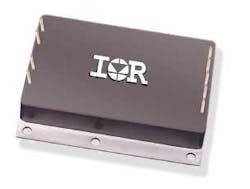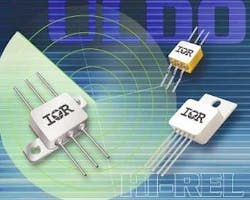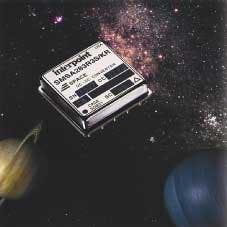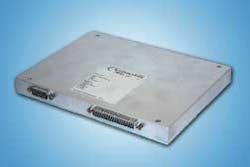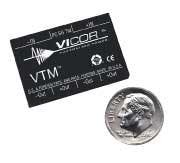Power-electronics designers customize components to be fast, light, and inexpensive as systems integrators shift their priorities from performance at any price to making difficult tradeoffs between cost and performance.
By Ben Ames
Modern military equipment must be reliable and inexpensive, as designers rely on electronic components to ensure high performance on the digital battlefield.
In the 1990s, Pentagon planners insisted on performance as the top factor. Today, thanks to more reliable factories, that performance is taken for granted, and suppliers report demand for power electronics that are small, powerful, and customized for every application.
Buyers specify low cost, small size, and fast design changes to fit their systems perfectly. Still, the laws of physics demand the standard parts: metal-oxide- semiconductor field-effect transistors (MOSFETs) — and their inexpensive cousins, the insulated-gate bipolar transistors (IGBTs) — rectifiers, transistors, thyristors, and transient voltage suppressors.
These parts are all getting lighter and more mobile in response to demand by American military planners who are transforming their warfighting strategy from slow, deliberate assaults to quick, clandestine strikes. For manufacturers of electrical components, this is a call to design more efficient components that minimize current draw and power dissipation.
Some of the greatest power loss comes from MOSFETs, since semiconductors handle the heat, says Jim Grozier, director of technical marketing at Vishay Siliconix in Santa Clara, Calif.
Most designs handle the power supply with up-front power conversion, but point-of-load rectification is more efficient because it works more closely to where the power will be used, Grozier says. One option is a pair of synchronous rectifiers, which alternate between the on and off state.
"Any current that sees resistance generates heat," Grozier says. "If it's off, there's no resistance. But there's capacitance while it's switching, too. That's a tradeoff in MOSFET design — you have to choose either low on-resistance or low capacitance."
However, Vishay engineers say they found a way to have the best of both worlds — they created the WFET. A typical MOSFET uses V-shaped trenches, while the new design uses W-shaped trenches. The new shape allows it to switch and remain on simultaneously, boasting low power dissipation in either state.
"This could be the tip of the iceberg for further technology advances," Grozier says. "It's three or four percentage points more efficient than others."
Vishay officials released the new design in June and are working to guarantee a constant supply.
COTS, MOTS, HOTS, ROTS
Efficient parts are useless to military and aerospace applications unless they can survive rough conditions in the field. Designers of military electronics typically use expensive metal or ceramic cases to protect sensitive components; but faced with new cost constraints, they need more options, Grozier said.
So Vishay officials have introduced a line of what they call "quasi-military" parts that fit in between inexpensive COTS (commercial off-the-shelf) and tough MOTS (military off-the-shelf).
Vishay workers now build components in partially ruggedized classes called HOTS (hermetic off-the-shelf) and ROTS (ruggedized plastic off-the-shelf).
HOTS parts can stand up to environmental stress, but they are not screened to full military "shake, rattle, and roll" standards, company officials say. Vishay workers save costs by screening the parts statistically, not physically, Grozier says.
In contrast, full military screening of ROTS ensures that they offer high-reliability performance, but they are only rugged enough to operate in clean, sealed environments.
ROTS parts are designed for applications such as cell phones and personal digital assistants, which are usually sealed at the board level, not the component level. Other customers have specified ROTS parts for missile avionics.
"If a COTS part is 40 cents at the low end, and MOTS is $40 fully screened, then our HOTS and ROTS would be in the middle, at $4," he says.
Vishay plans to quote a defined part for mass production early next year. The company is not alone in the market; other electronics suppliers — such as Texas Instruments and National Semiconductor — are cutting prices by ruggedizing components with plastic, Grozier says.
Heat rises in sealed parts
Battlefield electronics use strict standards for hermetic sealing to safeguard electronic parts from contaminants such as sand and water. As a side effect, those strong compartments also keep the heat inside, which limits the power and number of components that designers can squeeze inside.
Today, electronics manufacturers are building components with relatively low voltages. Logic devices and microprocessors that used to run at 5 volts will now run at 3.3, 2.5, or 1.8 volts.
Yet engineers still struggle to disperse heat from those components, which pack more circuits into a tiny space, says Ed Fuhr, vice president of power solutions for Interpoint, a division of Crane Aerospace and Electronics, in Redmond, Wash.
"A device could still use 100 watts at 1.8 volts, though it had previously used 100 watts at 5 volts," he explains. "That's because its processing power has come up fourfold. There's much more data to handle now."
There is also less money to spend on solving these problems.
"Five or 10 years ago, performance was king at any price, even if it took longer to build," Fuhr says. "Now there's a lower tolerance for schedule and budget overruns."
Therefore, Interpoint engineers are finding ways to boost power density, primarily by filling out their existing product lines with lower-voltage versions, says Simon Abel, director of business development for power and space products at Interpoint.
Interpoint engineers are also building products that can withstand a wider range of input voltage, to be compatible with different vehicles. Compared to the standard range of 18 to 36 volts, new Interpoint products can cope with 16 to 40 volts, and one even works from 12 to 50 volts, says Donna Bliss, director of power and space products.
Parts get smarter
To make electronics more reliable, engineers are using new technology, to reduce the number of redundant parts in classic avionics designs.
The latest solid-state power controllers can detect a shorted load, overvoltage, or undercurrent. They can survive the threat and report the condition back to a central computer. In turn, the computer can route the power through a redundant part if necessary and note the change for maintenance.
Designers also are making solid-state relays with features previously found only on power controllers, says Bill Cantarini at Teledyne Technologies Inc. in Los Angeles. Teledyne engineers are adding features that can indicate when a part is wearing out, not just when it breaks.
"A circuit breaker could detect a shorted load if someone placed a screwdriver across two contacts. But it couldn't detect a loose wire or load arcing," Cantarini says. Designers of ground-based electronics have created an arc-detecting circuit breaker, but it is still in demonstration and verification, not yet ready for avionics.
Soon, avionics components will monitor system health through feedback from loads, and offer arc-fault protection and shutdown. Researchers on an avionics subcommittee at the Society of Automotive Engineers (SAE) in Warrendale, Pa., are nearly done drafting a specification for the new technology, Cantarini says. Officials at the U.S. Federal Aviation Administration (FAA) in Washington will then decide whether to encourage it in future designs.
The change would affect commercial airplane designers first. For instance, FAA regulators now require fuel tanks be equipped with ground-fault circuit breakers. Such a design might have avoided the TWA Flight 800 disaster, which killed 230 people in a crash off Long Island, N.Y., in 1996, officials claim.
The change could save money for commercial and military designers because planned maintenance is less expensive than emergency repairs, Cantarini says.
All these advances blur the line between relays and power controls. For certain applications, designers can get the same features in an inexpensive plastic relay as in a costly ceramic power controller. Still, some differences remain: relays do not draw power off the load that drives the switch circuitry, while power controllers and intelligent power switches do.
Cost is still an important difference. Contractors for the Joint Strike Fighter — including Teledyne — had to meet stringent cost requirements in supplying their components, he says.
One way to meet that price pressure is through packaging. Electronics packaging has progressed from large metal packages, to small metal packages, to ceramic, and now, to plastic.
Plastic parts provide decent environmental ruggedness, as long as they stay in a friendly space, like the fuselage. Commercial designers were the first to use plastic-packaged electronics, citing weight and cost benefits on airplanes for Boeing and Airbus.
Meanwhile, builders of military planes still use more rugged ceramic parts in their designs for planes such as the F-22 and European Fighter Aircraft (EFA), Cantarini says.
Combining efficiency & power
Military-electronics designers are always looking for ways to boost power density for applications in fighter planes, space, reconnaissance aircraft, ground systems, communications, and missiles. At the same time, they try to increase efficiency so those systems will show great endurance. Now they can do both at once.
Factorized Power Architecture (FPA) is enabled by VI Chips from Vicor in Andover, Mass., in a surface-mount BGA package. FPA makes the most of a power system by providing a higher degree of system flexibility, power density, conversion efficiency, transient responsiveness, noise performance, and field reliability than conventional products, says Keith Nardone, senior product marketing manager, military products at Vicor.
The enabling chips — a Pre-Regulator Module and a Voltage Transformation Module — can operate alone, together, open loop, local loop, adaptive loop, remote loop, collocated, separated, paralleled, or combined with conventional power-conversion devices (for example, DC-DC converters, point-of-load converters, and charge pumps) to achieve the desired power solution.
High-efficiency, low-parts-count, and molded packaging enable VI Chips to operate in harsh environments, Nardone says. Vicor introduced FPA last year and plans to begin full production this year.
Efficient mobile devices
In 21st century warfare, troops depend on mobile electronics for battlefield survival, from radios and night-vision scopes to global positioning systems (GPS). For designers of power electronics, that means three design goals are paramount: reduce size, weight, and power consumption.
Designers can boost endurance for mobile electronics either by choosing better energy storage or by using more efficient electrical components. Yet battery technology has hit a plateau, and fuel-cell technology is still several years away, so efficiency is the only option, says Bryan Rogers, vice president of International Rectifier. The company's high-reliability group is based in Leominster, Mass.
Company engineers have reduced size and increased efficiency for new products this year, reducing voltage to boost power density.
The A1275 series of DC-DC converters is compatible with the 28-volt power bus standard on most military vehicles, MIL-STD-1275. Mobile electronics must also handle varying voltages from the engine, battery, and generator, so a DC-DC converter absorbs those transient levels.
Designers shaved price instead of weight from the A1275 design, a crucial step as military buyers continue to specify more COTS components. So designers built the A1275 to match the specific environmental demands of each application, instead of assuming every job needs hermetic — and expensive — fully rugged housing.
"You can address ruggedness with either the enclosure or the components. So you might decide to use the A1275 that covers your temperature range, and use the final packaging for moisture protection," Rogers says.
The company builds hermetically sealed housings for high-reliability products, such as MOSFETs, IGBTs, voltage regulators, and rectifiers, as opposed to their plastic-packaged commercial line. Module-type products — such as DC-DC converters, motor converters, and the A1275 — are not hermetically sealed.
Those products satisfy International Rectifier customers who demand low prices today, compared to their demands for high performance 10 years ago, Rogers says. Those customers are building similar systems, but they are adding more electronics capability, such as voice and data communications, GPS units, and fire control for weapons systems.
Therefore, the company also builds the new ULDO, a high-efficiency, ultra-low-dropout voltage regulator. Customers order the piece in various hermetic packages to suit the power conservation and environment for each portable military application.
Engineers with Solitron Devices in West Palm Beach, Fla., have expertise in Thick-Film Power Hybrid Technology, which provides a wide range of sophisticated MOSFET, bipolar, and Schottky power hybrid circuits that incorporate small-signal, monolithic-integrated circuits and power semiconductors into one "mini" package.
Hybrid technology has proven to be the solution to the growing demand to increase circuit performance while reducing the space required for such performance and improved reliability because of the testing and screening of an entire circuit, rather than only the individual components, Solitron officials say.
Solitron is on most U.S. military programs and most U.S. and international space applications, company officials claim.
Complex systems, more watts
Making electronics efficient and powerful is a challenge because power density is rising so fast. Recent products tend to have higher wattage with smaller packaging, says Lou Garofolo, sales engineer in the power supply division at North Atlantic Industries in Bohemia, N.Y.
In part, that is because manufacturers of electronic components are using lower voltages, migrating from 5 volts to 3.3 and less. Instead of dropping, the total wattage rises because designers can pack more components into each box, Garofolo says.
As more components are integrated into each product, markets for embedded power supplies and embedded input/output increase, Garofolo says. North Atlantic Industries competes for that market share based on extra ruggedness and rapid design, not on low prices, he says.
"We keep inventory on hand to customize on-the-fly for high-volume jobs. Our goal is to provide a customized solution within six to eight weeks, which is half what we and the industry were doing last year."
Engineers must work even faster because customers often specify the power supply as the final part of a design. "They figure out the system requirements, and then they demand a certain number of watts," Garofolo says.
Company engineers offer four examples of rugged power-supply products built in this mold.
The 64PS1 is a 600-watt DC-DC converter with 28-volts input, used to drive the forward-looking infrared camera (FLIR) on Predator unmanned aerial vehicles.
The 55PQ1 is a 28-volt, 200-watt DC-DC converter that acts as a VME or Compact CPI power supply, and is mounted on the baseplate so it is conduction cooled through the chassis. That helps designers avoid using fans, which do not work inside hermetically sealed components, take up extra space, and break down more often than solid-state designs, Garofolo says.
The 58P71 is a 250-watt, VME AC/DC power supply used as a component in BAE Systems' flightline tester, allowing troops to perform mobile diagnostics on aircraft.
And the 56ST1 is a 600-watt, 115-volt AC, VME power supply designed for shipboard applications.
International Rectifier releases rad-tolerant DC-DC converters for space
Officials at International Rectifier (IR) in El Segundo, Calif., recently released their the AMA series (5 watt), AMF series (12 watt), and AMR series (30 watt) radiation-tolerant, high-reliability DC-DC converters designed for extended operation in moderate-radiation environments.
The new converters are standard, off-the-shelf units that solve the space industry's problems of lengthy design cycles and extensive design analysis requirements for custom units, IR officials claim. The small size and low mass make the converters ideal for point-of-load regulators or as a building block in a power system for low-Earth orbit (LEO) satellites and launch vehicles, company officials say.
The AMA, AMF, and AMR converters feature high tolerance to total ionizing dose (greater than 25 kilorads), heavy-ion single-event effects, and environmental stresses such as temperature extremes, mechanical shock and vibration.
Bryan Rogers, vice president of sales and marketing, high-reliability products, says the new AMA, AMF, and AMR converters will help integrators and designers save valuable time compared to custom solutions.
The new DC-DC converters have a 28 volt input, with standard output voltages of 3.3, 5, 12, and 15 volt for single-output models, as well as plus/minus 5 volt, plus/minus 12 volt, and plus/minus 15 volt for dual output models. A separate MIL-STD-461C compliance filter is also available, company officials say.
The AMA Series converters weigh less than 32 grams, the AMF Series converters weigh less than 36 grams, and the AMR Series converters weigh about 2 ounces.
Operating temperature for each of the converters is –55 degrees to 125 degrees Celsius, and includes an on/off command. The devices have MIL-STD-461C, CE03, and CS01 compliance with an external filter.
Aeroflex releases four DC-DC converters for avionics applications
Officials at Aeroflex in Plainview, N.Y., expanded their power-product line with four new DC-DC converter products to enhance their current line of aerospace, avionics, and ground-based systems. The new DC-DC converters join Aeroflex's power family of motor controllers, DC motor drivers, custom power MOSFET modules, 16-bit monolithic RadHard tracking resolver-to-digital converters, voltage regulators, and microprocessor-controlled quad solid state relays.
The new DC-DC converters, the ACT8631/8632/8633/8634, offer a variety of voltage outputs and radiation levels as high as 300 kilorads and are hermetically sealed, Aeroflex officials say. Aeroflex is a MIL-PRF-38534 Class H and K qualified supplier and ISO9001-2000 as well as AS9100 certified. The 8630 Series is built on the company's Class K line and eventually will be available with an SMD number, Aeroflex officials say.
Evaluation samples of the ACT8631/ 8632/8633/8634 are readily available. Flight units are available in the end of the year. The ACT8631 Series is $12,500 in lots of 10.
Aeroflex provides application-specific multichip and hybrid modules, standard memory and MIPs, and microprocessor-based products for satellite, military, and avionics applications. Other products offered are high-reliability motion-control subsystems, DC brushless motors, motor drivers, DC-DC converters, single-board computers, RF and fiber-optic products, SMT and chip onboard modules.
